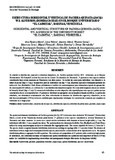| dc.rights.license | http://creativecommons.org/licenses/by-nc-sa/3.0/ve/ | |
| dc.contributor.author | Moret, Ana Yajaira | |
| dc.contributor.author | Valera, Lino | |
| dc.contributor.author | Mora, Argenis | |
| dc.contributor.author | Garay, Vicente | |
| dc.contributor.author | Jeréz R., Mauricio | |
| dc.contributor.author | Plonczak Ratschiller, Miguel Andrés | |
| dc.contributor.author | Ramírez, Nelson | |
| dc.contributor.author | Hernández, Dimas | |
| dc.date.accessioned | 2009-07-15T21:36:34Z | |
| dc.date.available | 2009-07-15T21:36:34Z | |
| dc.date.issued | 2009-07-15T21:36:34Z | |
| dc.identifier.uri | http://www.saber.ula.ve/handle/123456789/28976 | |
| dc.description.abstract | Se estudió la distribución espacial y estructura diamétrica, de Pachira quinata (JACQ.) W.S. Alversons, en el Bosque
Universitario “El Caimital”, relicto boscoso de los Llanos Occidentales de Venezuela. P. quinata es una especie arbórea considerada bajo severa amenaza en Venezuela y en otros países. Se realizó un censo para individuos con diámetro a la altura de pecho (dap) ≥ 5 cm, y un muestreo para los individuos con dap < 5 cm. El patrón espacial se determinó mediante los índices de Cox, Eberhardt y Clark-Evans, utilizándose el análisis de semivariogramas para determinar el grado de agregación. El censo reportó 643 árboles, (1,2 árboles ha-1) con distribución diamétrica regular. No se encontró regeneración en los estados de brinzal y latizal (dap < 5 cm). La ausencia de individuos en estas etapas ha sido reportada para esta especie y podría ser una característica de su ciclo reproductivo. P. quinata se distribuye en agregados con un tamaño estimado en 600 m. La población estudiada, con abundancia relativamente alta, bien estructurada en términos de distribución espacial y diamétrica, en un lote boscoso protegido (579 ha) la hacen candidata para implementar estrategias de conservación y manejo que aseguren su viabilidad en el largo plazo. | es_VE |
| dc.language.iso | es | es_VE |
| dc.rights | info:eu-repo/semantics/openAccess | |
| dc.subject | Biodiversidad | es_VE |
| dc.subject | Conservación de especies | es_VE |
| dc.subject | Distribución espacial | es_VE |
| dc.subject | Estructura de poblaciones | es_VE |
| dc.subject | Pochote | es_VE |
| dc.subject | Saqui-saqui | es_VE |
| dc.title | Estructura horizontal y vertical de Pachira Quinata (Jacq.) W. S. Alverson, (Bombacaceae) en el bosque universitario “El Caimital”, Barinas, Venezuela | es_VE |
| dc.title.alternative | Horizontal and vertical structure of Pachira Quinata (Jacq.) W. S. Alverson in the university forest “El Caimital “, Barinas, Venezuela | es_VE |
| dc.type | info:eu-repo/semantics/article | |
| dc.description.abstract1 | The spatial and diameter distributions of Pachira quinata (JACQ.) W.S. Alversons were studied at “El Caimital”, Universitary
Forest, a relict of the Venezuelan western plain forests. P. quinata is a tree species considered as severely threatened in
Venezuela and other countries. A census was carried out for individuals with diameter at breast height (dbh) ≥ 5 cm. For
individuals with dbh < 5 cm a sample was taken. The spatial pattern was determined with the Cox, Eberhardt, and Clark-Evans
indices by using semivariogram analysis to determine the aggregation rank. The census reported 643 trees (1.2 trees ha-1).
The species shows a regular diameter distribution, however no seedlings or saplings (dbh < 5 cm) were found. The absence of individuals in these stages has been reported for this species, and could be a characteristic of its reproductive cycle. The
spatial distribution pattern is aggregated in 600 m patches. The existence of a population of P. quinata, with a relatively high number of individuals, well structured in terms of diameter and spatial distributions on a protected and large tract of forest (579 ha) makes it a candidate for implementing conservation and management strategies that ensure its long term viability. | es_VE |
| dc.description.colacion | 62-74 | es_VE |
| dc.description.email | aymoret@ula.ve | es_VE |
| dc.description.email | lvalera@ula.ve | es_VE |
| dc.description.email | amora@ula.ve | es_VE |
| dc.description.email | vgaray@ula.ve | es_VE |
| dc.description.email | mjerez@ula.ve | es_VE |
| dc.description.email | plonczak@ula.ve | es_VE |
| dc.description.frecuencia | semestral | es_VE |
| dc.identifier.depositolegal | 198802ME173 | es_VE |
| dc.subject.keywords | Biodiversity | es_VE |
| dc.subject.keywords | Pochote | es_VE |
| dc.subject.keywords | Population structure | es_VE |
| dc.subject.keywords | Saqui-saqui | es_VE |
| dc.subject.keywords | Spatial distribution | es_VE |
| dc.subject.keywords | Species conservation | es_VE |
| dc.subject.thematiccategory | Medio Ambiente | es_VE |
| dc.subject.tipo | Revistas | es_VE |
| dc.type.media | Texto | es_VE |



